Hello! This is Everything Is Amazing, a science-obsessed newsletter about curiosity and awe, weirdness and wonder.
Today, as something of a coda to last season’s fascination with massive geological spasms of chthonic fury, let’s head over to…what I previously thought was the unlikeliest place in the world for such things.
These are the White Cliffs of Dover, on England’s extreme southeast coast. They’re just over a hundred metres tall and stretch for about 12 kilometres, they’re made of chalk streaked with black flint, and they’re all that’s left of a strip of land that once stretched 30-ish kilometres to modern-day France.
I already knew two of these things, and I thought I knew about the third.
I knew that the recent history of our planet is one of waxing and waning ice ages, and when the water of the oceans was mostly locked up in great glaciers hugging the polar regions, you could have walked across the bed of what’s now the English Channel.
Have you ever stood at a cliff’s edge and tried to imagine away the sea? It’s fun! Have a go. What would be left, with all that water gone? I do this a lot, and it usually makes me feel dizzy and nauseous and deeply appreciative of the ground I’m standing on. (Once I even threw up! Imaginations are hilarious.)
In most cases, with the ocean removed, you’re suddenly thrust high into the air. Before you were at “sea-level” (aka. as low as you can go), and now you’re in the highlands. You’re looking out over a valley, or a canyon, or peering over a precipice. Much more of everything is now down.
Just as our inability to see far underwater turns the sanity-bending scale of our ocean floors into something we hardly think about, the presence of sea and its light-reflecting qualities focuses our gaze and our thoughts on the shoreline, not on what it’s interrupting.
But if we could truly see what’s down there? Perhaps we’d experience a version of The Overview Effect (the humbling perspective shift that left William Shatner so flummoxed during his recent trip into space), but going the other way, downwards, towards the vastly greater volume of space on the surface of our planet that most of us barely think about?
Anyway. What you’d probably see from atop the White Cliffs of Dover is a muddy marine valley, 26 miles wide at its narrowest point, and mostly lined with chalk, through which the Channel Tunnel cuts:
As I’d been taught at school, millions of years of flowing seawater had gently nibbled down this landscape from whatever it was to start with. Probably a river? A river that gradually widened over inhuman amounts of time, tearing away more and more of the relatively soft chalk until Great Britain (apart from times when the sea level was unusually low) was an island.
This is the gradualistic, deep-time model of geology that ties in with the fashionable uniformitarian ideas of pioneers like Lyell and Hutton. This slow-but-sustained thinking was partly a reaction to catastrophism, the belief in sudden great dramatic upheavals that always seemed to turn back to stories of Noah’s Ark and the like. Well, pshaw and poppycock and flapdoodle to all that guff: couldn’t Science do better than merely acting as a prop for the Bible? And wasn’t there in fact a wealth of empirical evidence for incredibly-long-term processes making such changes on their own?
Sure! But hey, why can’t both be correct?
This is what geologists believe today (and to be fair to Lyell and Hutton, they both accepted the power of sudden great changes, although as rare exceptions to the rule). It’s now understood that the world changes gradually, and the world changes suddenly, and both can apply at any time.
But in particular, it’s now understood just how amazingly quickly - and how enormously - the surface of a planet can be altered by staggeringly violent events that we’d have labelled “natural disasters” if we were unlucky enough to be around to see them.
Here’s one example:


(Ye gawds.)
Oh, and that asteroid that wiped out the dinosaurs 66 million years ago? From a study published on October 4th, it seems to have generated tsunamis on a scale I doubt many of us considered possible until now:

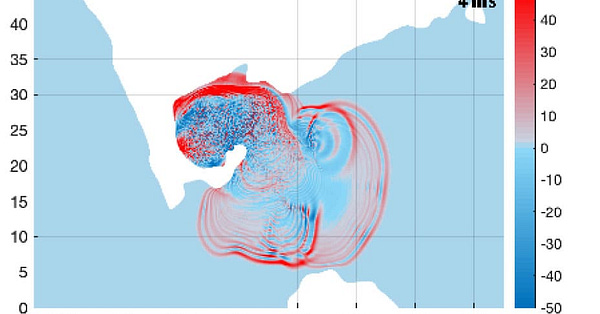
The tallest of these megatsunamis are projected to have been the same height (around 4,000 ft) of the wave from that bloodcurdling scene in Interstellar:
So, yes. BIG THINGS CAN HAPPEN SUDDENLY.
Regarding the shores of my own country, I really should have kept this in mind. I’ve been writing about such things since February, starting with the Zanclean Megaflood (the reason around half of you started reading this newsletter, thanks to a viral Twitter thread), and the Storegga tsunami that engulfed what remained of Mesolithic Doggerland around 8,000 years ago.
But the English Channel? Oh come on. This is the UK. Things have a habit of not happening here (earthquakes, volcanoes, revolutions, tolerable weather, displays of genuine emotion). That’s what it’s famous for! What could possibly happen here that could be labelled High Drama?
Well, one answer to that question could be “everything in our politics since 2016” - but the more considered and relevant scientific response is “everything happens everywhere, if you give it enough time.”
And this is how I learned that around 425,000 years ago, the island of Great Britain was wrenched away from Europe in a fashion more dramatic than the fevered dreams of any hardline Brexiteer, by a single flood so violent that it could part continents.
Here I’m indebted to Professor Lewis Dartnell, whose superb book Origins tipped me off about the Dover megaflood for the first time:
“Half a million years ago, Britain was not an island. It was still part of continental Europe, physically connected to France - like conjoined twins - by an isthmus running between Dover and Calais. The land bridge was a continuation of the hump-shaped geological structure known as the Weald-Artois anticline that stretches from south-east England to north France, formed of layers of rock buckled upwards in the same tectonic upheaval that created the Alps when Africa slammed into Eurasia.
The land bridge between England and France was eroded away to sever this connection, and this seems to have occurred in a sudden, catastrophic event. Sonar maps of the English Channel distinctly reveal an unusually straight and wide valley on the seafloor, containing streamlined islands and long, kilometre-wide eroded grooves - clear signs of a huge flood of water coursing over the ground.”
The bathymetry data collected and studied by marine geophysicist Jenny Collier of Imperial College and colleagues was published here in 2015, and showed 36 underwater “islands” formed of bedrock - the harder stuff left exposed once the softer surrounding material had been scoured away.
This supported an earlier study by Sanjeev Gupta of Imperial College London showing the marks lefts on the sea floor by a sustained torrent of water, in much the same fashion as those left on the floor of the Gibraltar Strait by the proposed Zanclean flood.
Dartnell continues:
“During the ice age around 425,000 years ago (five ice ages before the most recent glaciation) a vast lake of water became trapped between the Scottish and Scandinavian ice sheets and the 30-kilometre-wide ridge of rock then still linking England and France. This lake was filled with meltwater from the ice sheets as well as discharge from rivers like the Thames and Rhine…”
“And with no outlet to escape through, the water rose and rose, until inevitably it began to spill over the top of the land bridge. These colossal waterfalls scooped out massive plunge pools on the channel floor and gouged backwards through the barrier until this natural dam collapsed. The entire lake emptied itself in a catastrophic megaflood, widening the gaping breach in the barrier and carving the landforms on the floor of the Channel we can see with sonar today.
This first megaflood 425,000 years ago is thought to have been followed by a second event around 200,000 years ago, and between them they wore away what is now the Strait of Dover, leaving the white cliffs as the stumps of the former isthmus.”
Gupta’s team estimated the flood was pumping 1 million cubic metres of water per second - for months. That’s roughly a hundred times the Mississippi river today, and a thousand times the normal flow of the Rhine. I’d consider that completely insane, if I didn’t remember than the Zanclean Megaflood was a hundred times more powerful still. Nevertheless: whew.
Was anyone around to see this monster of an event? Possibly! There are footprints of early hominids in modern-day Norfolk dating back 900,000 years (Homo sapiens would take another 600,000 years to arrive, as far as we know). But they, like every other living creature, must have retreated from the advancing glaciers of each ice age to seek out more habitable lands further south, only to return (as a species, I mean) when the world’s climate warmed again.
(I’d prefer to think there was nobody around to see the English Channel megaflood. There’s only so much the human mind can take.)
So that’s what you’d see from the cliffs of Dover, if the seas boiled away before your eyes. You’d see the remnants of an ancient chain of waterfalls on a scale dwarfing anything visible today. That’s what our Chunnel trains whisk us under when we go to France, and that’s what our aged but stalwart ferries sail over.
Then you’d have to imagine the chalk under your feet stretching forward into thin air, 110 metres above the now-placid sea, and forming a ridge of land that runs almost to the horizon, to the distant smudge of shadow that marks the French coast - and then imagine it all being torn away in front of your eyes, until you were suddenly standing on an island.
As we say round these parts: blimey.
- Mike
Images: Peter Mason; The Geological Society; Science.org; Jenny Collier.

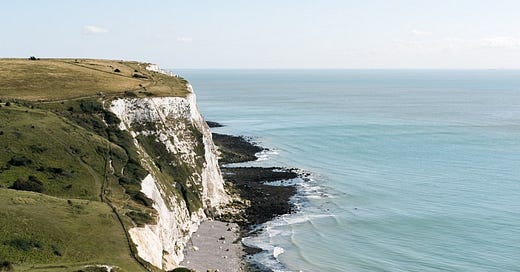



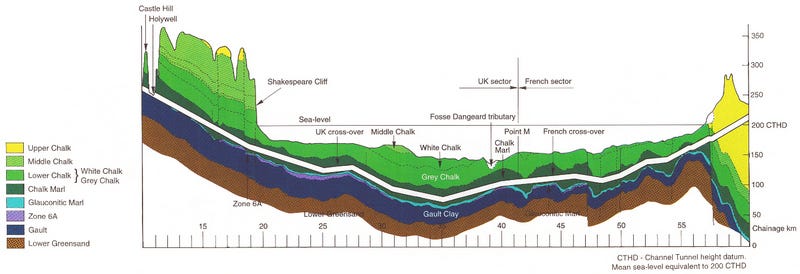
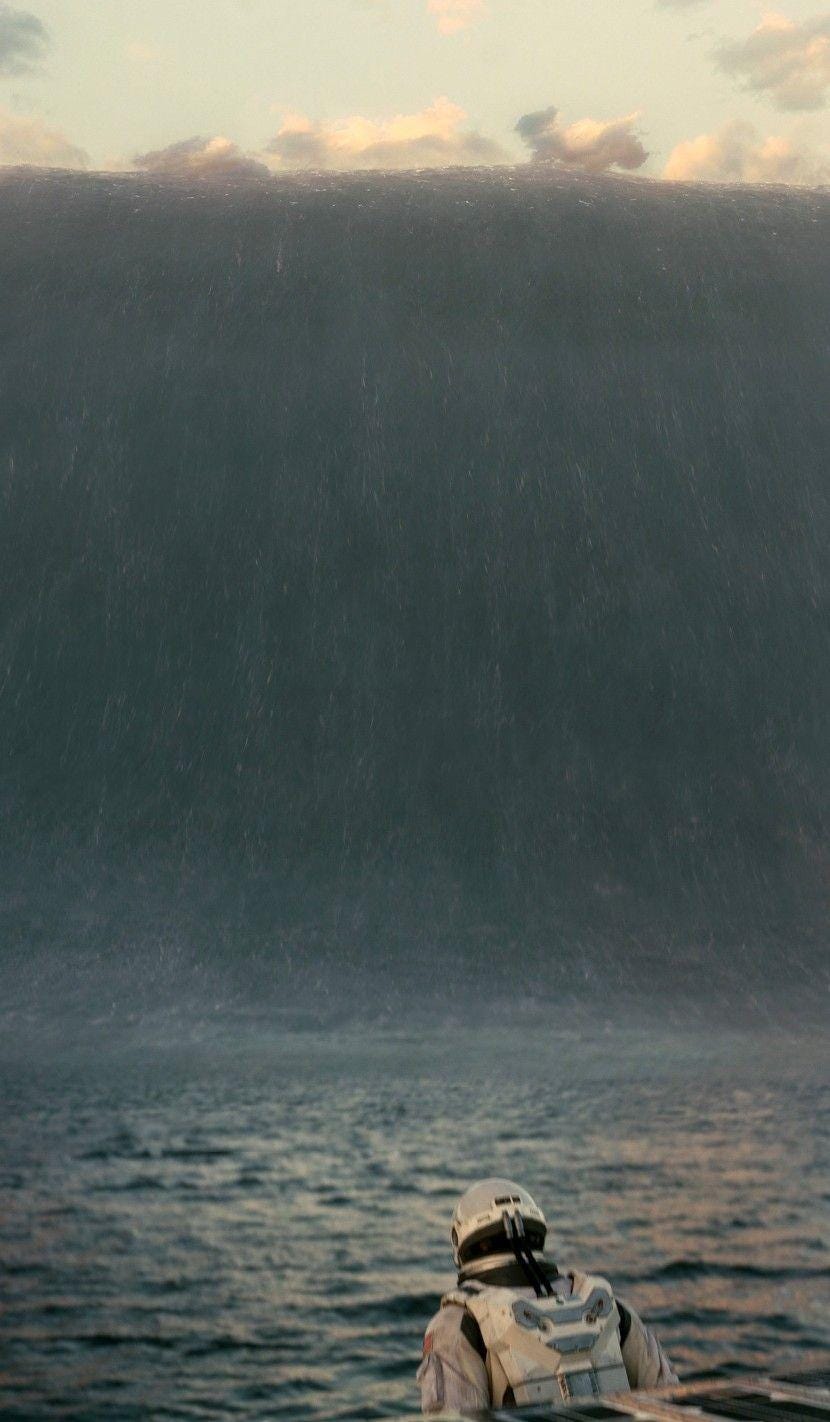
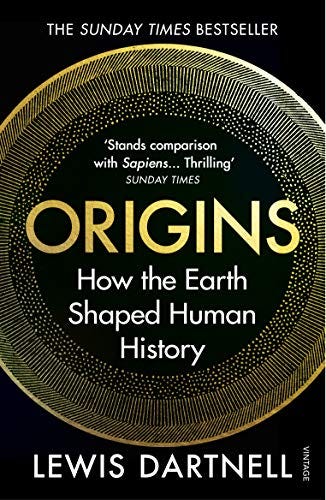
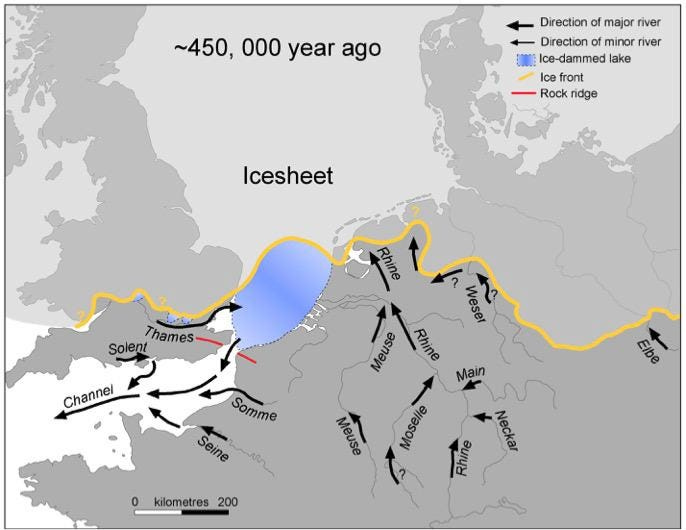
This is only the second of your amazing articles I have read, the first one being about Asher's artwork.
Please excuse the spelling but I am recently back from the Heart Hospital following a stroke and then a heart attack " black " eye. More specifically the black blob hanging to the left side of my nose is in my left field of vision which is currently unavailable to take signals from either orb, leaving me with a rather fuzzy picture of the world that does not comport with the way that I've always read a line at a time because I'm not sure where that line begins because I have some kind of ghost writing hanging to the left of the screen.
Proofing and editing are also difficult but I will try to clean up areas that are likely to be confusing to a reader.
What I wanted to say in this besides sniveling about my difficulties is that you are a really good writer and write about very interesting topics which I have been reluctant to pursue because I knew they would hook me in and at 80 years old with a very complex family life and a high maintenance lifestyle of exercise, nutrition and sleep and "a head full of ideas that are driving me insane" and recent DNA driven heart problems that have made it obvious I do not have forever to download those ideas and I don't want them turned to ashes, no matter how decorative the urn.
I did not intend to read this one but the word Mega flood drew me in and caused me to return three or four times after I stepped out to do something and had to rapidly scroll through to find my place again until I finally finished it this morning.
As I suspected not only did I find your topic to be amazing but you're writing to be amazing as well, including not only your ability to convey the all you feel at such amazing events but also those little aside comments about Britain's lack of tolerable weather and detectable emotions.
I always said that I wish Isaac Asimov had written all my high school textbooks and I would put you in that same category along with folks like Arthur Clark and Robert Audrey.
Perhaps if we somehow muddle through this current anti-science authoritarian mess we're in perhaps we will take steps to see that understanding how things work would go a long way towards useful solutions that don't involve Jewish space lasers and other total nonsense.
Having met you on the writers it is obvious to me that you are not only a good writer but a good person and with your educational bent can be part of the solution instead of part of the problem although it's going to take a good Mass psychologist to help us figure out how to educate people who do not think everything's amazing but rather simple and any hint of nuance is some kind of "woke" conspiracy to undermine the natural order of white male superiority as was firmly established and the collection of Legends and folk wisdom known as the Bible.
That bit about the human footprint made me wonder if at least some of the minor Mega floods might not have been witnessed and passed on, with a little extra baggage like " and God did that to punish the Wicked Ways that I don't agree with, so God must not agree with them either and you better look out or God and I will get you again!"
I have apparently wasted enough of your time already and as I Tire I find my thumb hitting the wrong place more often, creating even more confusion in my healing brain so it's time for lunch and a nap to reboot.
Your wide-eyed wonder, which you capture in a way that is both visceral and utterly charming, is a gift for all of us. To be all sappy and decidedly not-British about it. Thank you. 😊